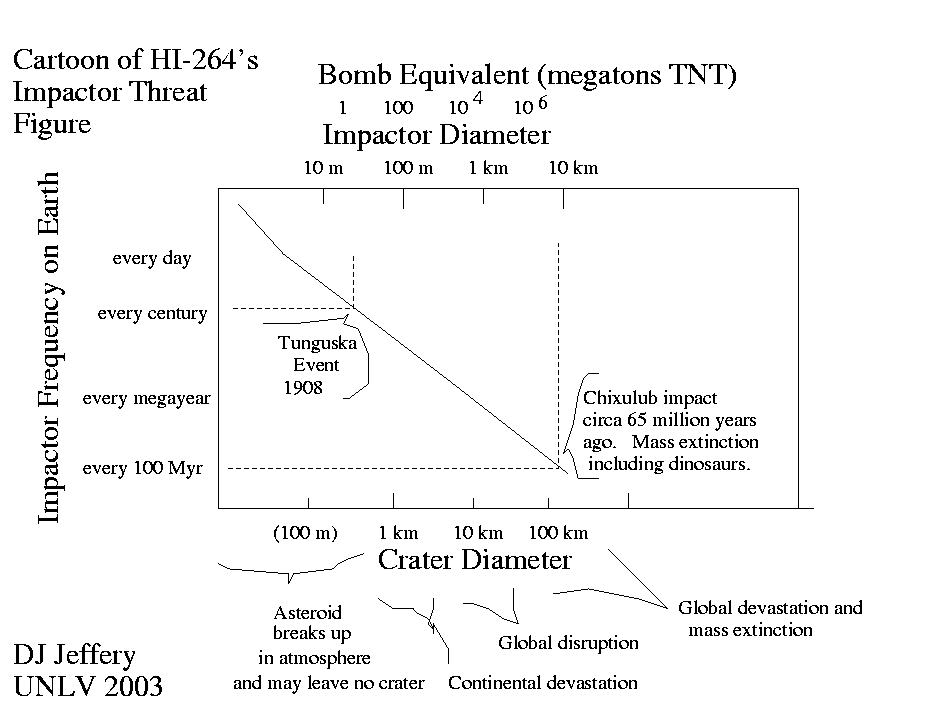
Caption: A cartoon of an impactor threat diagram (based on HI-264).
This impactor threat diagram is out-of-date and should only be taken as good to order of magnitude or so.
An up-to-date impactor frequency table, is at Wikipedia: Impact event: Air bursts. Note this table is subject to large revisions as improves our knowledge of the statistics of near-Earth objects (NEOs).
What is the current Earth impactor threat?
- From the
impactor threat diagram
and, more accurately, the
impactor frequency table,
we can assume that sooner
or later we will find a
Tunguska event-size
Earth
impactor (i.e.,
a 50-m size-scale astro-body:
Wikipedia: Tunguska event) that will
impact within a few centuries.
Note the impactor frequency table suggests 30-m size-scale astro-bodies impact every ∼ 200 years. So there is likely one with our number on it lurking out in the darkness of outer space.
On the other hand, the impactor frequency table suggests 1-km size-scale astro-bodies impact every ∼ 0.5 Myr. Unless we are very unlucky, we do NOT need to worry about these astro-bodies.
- Close-approach
astro-bodies
(which are usually asteroids
and meteoroids (⪅ 1m size scale))
are much more common than
impactors.
In 2020s, typically there
are of order 100 per year
observed
close-approach astro-bodies
that come closer than
Moon mean orbital radius (semi-major axis) R_Mo = 384,748 km
= 1.28338 light-seconds
= 2.57188 mAU
= 1.00091 LD
= 60.3229 R_eq_⊕ ≅ 60 R_eq_⊕ (center-to-center)
(Wikipedia:
List of asteroid close approaches to Earth
Timeline of approaches within one lunar distance).
Note the natural unit lunar distance (LD) = 384,399 km is an "average" distance to the Moon defined in a different way than the semi-major axis of the Moon's orbit relative Earth's center which is another sort of "average" distance to the Moon (Wikipedia: Lunar distance: Value; Wikipedia: Orbit of the Moon).
For most purposes, the distinction between lunar distance (LD) = 384,399 km and the relative semi-major axis of the Moon's orbit is negligible, and we usually ignore the distinction in this figure.
- Almost all of the close-approach
astro-bodies are NOT
impactor threats.
And almost all them are
30-m size-scale astro-bodies
or smaller.
The largest close-approach astro-bodies to within and beyond the Moon mean orbital radius are listed Wikipedia: List of asteroid close approaches to Earth: Objects > 50 meters.
The largest one known that came within the Moon mean orbital radius in the period 1926--2023 is (308635) 2005 YU55 (size scale 360(4) m, close approach 2011 Nov11, closest approach = 0.002172 AU = 0.8453 lunar distances = 50.94 Earth equatorial radii).
Of course, many close-approach astro-bodies from before circa 2000, now known about, were NOT observed at the time.
And new small close-approach astro-bodies in the past are still being discovered, but there are lots that will NEVER be discovered. Some because have disappeared since their closest approach because they impacted a large inner Solar System object (Sun ☉ (maybe ∼1/3 of the NEAs), Mercury ☿, Venus ♀, Earth ⊕, Moon ☽, Mars ♂) or were ejected (often by what can be called natural gravitational assists) out of the inner inner Solar System.
For where NEAs come from and where they go to, see Asteroid file: nea_apsidal_precession.html.
- Have certain impactors
ever been discovered before impact?
Yes, but only small impactors (size scale of order 1 to a few meters) only very briefly before impact (warning time < 1 day) for the period up to 2023. See Wikipedia: Asteroid impact prediction: List of successfully predicted asteroid impacts.
So we have NOT YET found a certain impactors well in advance.
- However, we are searching for
near-Earth objects (NEOs)
(i.e.,
near-Earth asteroids
(NEAs)
and
near-Earth comets (NECs))
both assess their threat and as interesting
astronomical objects.
The main searcher is NASA/JPL Center for Near Earth Objects (CNEOS, 1990s--). For CNEOS's current discovery statistics, see CNEOS: Discovery Statistics.
- What of dangerous NEOs?
First, note that orbits of NEOs are only knowable with decreasing accuracy/precision as time increases from the present. The reason for this is the smaller the astro-body, the more subject it is to astronomical perturbations whose effect can only be calculated approximately with decreasing accuracy/precision as time increases from the present.
Thus, so far, for known NEOs we can only predict the probabilities of them becoming impactors.
CNEOS maintains the automated Sentry Risk Table for NEOs that threaten Earth for the next few centuries.
The threat of the NEOs (i.e., potential impactors) in the Sentry Risk Table is ranked by the Palermo (technical impact hazard) scale which combines probability of impact and danger of impact with some weighting.
- As of 2024,
the most probable impactor
in the Sentry Risk Table is
2010 RF12
(see 2010 RF12: Earth Impact Risk Summary)
and it has only 10 % cumulative chance of impacting in the period
2095---2122
with the overwhelmingly most likely impact date being
2095
Sep05 (10 %
probability).
However, 2010 RF12
is just a 7 m size-scale object which will probably annihilate in
Earth's atmosphere without
any ground effect at all.
It would probably be an impressive fireball (a brighter than usual meteor) or bolide (a much brighter than usual meteor). See Wikipedia: Impact event: Airbursts for information on the brightness of meteor air bursts.
Impactors of order a few meters in size scale happen pretty frequently, but we've NEVER predicted one far in advance (see Wikipedia: Asteroid impact prediction: List of successfully predicted asteroid impacts; also see Wikipedia: NEO: Impact rate).
- According to the
Palermo scale,
the most threatening
NEO
is NEA
1950 DA.
For details, see
Asteroid file:
1950_da_orbit.html.
Image link: Itself.
Local fily: local link: impactor_threat_diagram.html.
File: Asteroid file: impactor_threat_diagram.html.